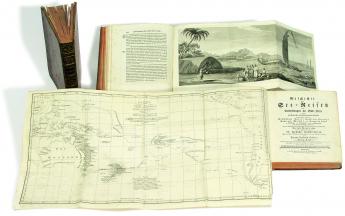Tip The Australian and New Zealand Association of Antiquarian Booksellers
Collecting European Australiana (Books on Australia from Continental Europe)

Harbeck Rare Books
Background
The early 17th century voyages of Spanish and Dutch navigators marked the beginning of European interest in Australia. A number of French voyages brought back news of Australia to Europe in the late 18th and early 19th century. Equally the English settlement of Australia attracted considerable attention on the Continent. From about 1840 the influx of people from Europe to Australia increased markedly. Among them were explorers, scientists and missionaries who contributed to the European knowledge of Australia through publications in their homeland. The literature of the 20th century firmly established Europe’s image of Australia as a continent of leisure and adventure.
Range
Collecting European books on Australia can concentrate on a number of fields, be it books in a particular language, on a favourite subject or a specific era. A collection of high points in this field would begin with the early European voyages to reach the Australian coast such as de Quiros, Jansz, Pelsaert, Tasman and de Vlamingh. The 18th century French accounts of the voyages of d’Entrecasteaux, Baudin and Freycinet are amongst the most beautifully illustrated and highly prized books of their time. Collectors should also aim to add to their collection the translations of the English voyage and travel accounts, particularly those of Dampier, Cook and Parkinson, the Forsters, Phillip, Flinders, Oxley and Leichhardt. European books on Australian Aborigines are plentiful and begin with the publications of European missionaries. The outstanding work in this field is Carl Strehlow’s fivevolume work on the Aranda. Many German speaking scientists settled in Australia in the 19th century, among them Blandowski, Becker and von Mueller. Some of their work was translated or appeared only in German. The late 19th and early 20th century saw European scientific expeditions come to Australia, such as those led by Richard Semon and Swedish entomologist Erik Mjöberg. As well as scientific results, these scholars also published popular accounts of their travels. An early scientific collector in Australia had been Amalie Dietrich. From 1863 until 1870 Dietrich collected for the private museum of the Godeffroy family in Hamburg. Scientists throughout Europe accessed this collection to publish books on Australian fauna and flora. Most notable among these was Ludwig Koch’s monumental monograph on Australian spiders. The 20th century saw an everincreasing number of European travellers reach Australian shores, many of them producing popular accounts of their trips. These in turn inspired a growing number of European works of fiction set in Australia.
Availability
While original editions of the 17th century voyages are all of extreme rarity, the later French voyage books come onto the market with some regularity. The translations of English sea and land voyage books, however, are almost all rare. Likewise, the major scientific books of the 19th century are of considerable rarity. The travel books and novels produced from about 1890 are generally available more widely, however fine copies are increasingly difficult to find.
Price
Many of the books published in the last 120 years are available for $100 - $1,000. Most of the scientific works published in the 19th century sell for $1,000 - $12,000 the major illustrated landmark works for considerably more. The voyage books of the 18th and early 19th century fetch upwards of $18,000. Original editions of the Spanish and Dutch voyages accounts are now essentially unprocurable, however later editions and translations of these sell for $2,000 - $8,000.
Footnote
There is a wide range of books dealing with the Europeans in Australia, particularly on the Dutch (Gunter Schilder), the French (John Dunmore) and the Germans (Johannes Voigt). Most of these books contain excellent bibliographies.
The article by Harbeck Books was first published in the “ANZAAB Aspects of Book Collecting” on www.anzaab.com, and is presented here, with our thanks, by permission of the ANZAAB.
